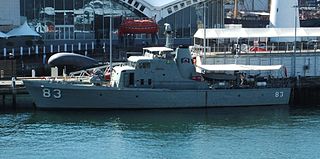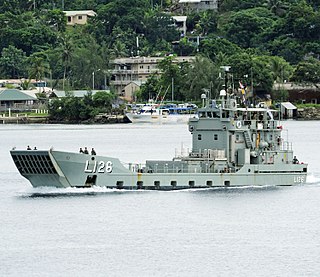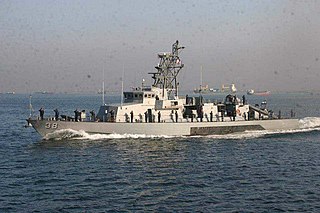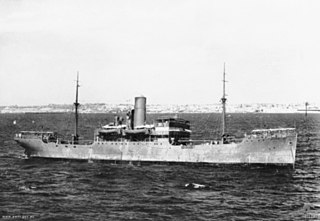Operational history
Yunnan was requisitioned by the Royal Australian Navy on 22 June 1942 and operated in North Queensland and New Guinea waters with her civilian crew. She was commissioned into the Royal Australian Navy as HMAS Yunnan on 20 September 1944 and sailed as part of the supply force for the Leyte campaign, then sailed for Hollandia. Although attached to the supply force for the military landings at Lingayen Gulf, Yunnan was not present at the landing. During the later part of 1945, she operated in New Guinea, Admiralty Group, Morotai, Tawi Tawi and the Philippines area, before returning to Sydney and was paid off on 31 January 1946. [2]
She was acquired by the British Ministry of War Transport before being returned to her owners. Yunnan was sold in September 1959 to Thai Navigation Company and renamed Hock Ann. She was sold in May 1963 to Guan Guan Enterprises and transferred to Guan Guan Shg. Company and renamed Kim Hock, before transferring to Hong Kong South Sea Shg. Company in October 1963. [2] Renamed Kario in May 1964, she was sold to Transportes Maritimos de San Blas, Panama in August. In 1965, she was transferred to Cia de Nav. Santos and renamed Bakna, before being renamed in 1966 Kario and later Murcia. Murcia was transferred to King Line S.A., Panama in 1966 and renamed King Eagle. In 1968, she was transferred to Guan Guan Shg. Company, Singapore and renamed Kim Hock, before being renamed Kim Hai in 1971. [2]
HMAS Acute was an Attack class patrol boat operated by the Royal Australian Navy (RAN).

HMAS Aitape was an Attack class patrol boat of the Royal Australian Navy (RAN). It was named for the small town of Aitape, Sandaun Province, Papua New Guinea. Completed in 1967, the vessel was one of five assigned to the RAN's Papua New Guinea (PNG) Division. The patrol boat was transferred to the Papua New Guinea Defence Force in 1974 as HMPNGS Aitape. She remained active until 1982, when she was removed from service for use as a parts hulk. Aitape was scuttled off Port Moresby for use as a dive wreck in 1995.

HMAS Ardent was an Attack class patrol boat of the Royal Australian Navy (RAN). She was built by Evans Deakin and Company, and was commissioned into the RAN in 1968. Ardent was decommissioned in 1994, then assigned as a navigation training vessel. At the end of 1998, she was removed from service. Initially marked for preservation at the Darwin Military Museum, the vessel was sold into civilian service in 2001 after the Northern Territory government declined. In 2002, the patrol boat was acquired by the Indonesian Navy, and commissioned as KRI Tenggiri (865) in 2003.

HMAS Attack was the lead ship of the Attack-class patrol boats used by the Royal Australian Navy (RAN). Launched in April 1967 and commissioned in November that year, the ship was largely commercial in design and was used to protect fisheries in Australia's northern waters, and to support the survey ship Moresby. The vessel remained in RAN service until 1985 when it was transferred to the Indonesian Navy and renamed Sikuda.

The Balikpapan class is a ship class of eight heavy landing craft. All eight were originally laid down by Walkers Limited for the Australian Army in the early 1970s. A reorganisation of watercraft responsibilities in the Australian military meant the landing craft were to be operated by the Royal Australian Navy (RAN), with seven commissioned directly into RAN service during 1973 and 1974, and lead ship Balikpapan transferred from the army to the navy. During the leadup to the independence of Papua New Guinea in 1975, two of the vessels were transferred to the new Papua New Guinea Defence Force (PNGDF).

HMAS Jervis Bay was a roll-on/roll-off passenger and vehicle ferry operated by the Royal Australian Navy (RAN) between 1977 and 1994.

HMAS Labuan (L3501) was a Mark III Tank Landing Ship that served in the Royal Navy during World War II, and with the Royal Australian Navy (RAN) from 1946 until 1951.

HMAS Bungaree was an auxiliary minelayer of Royal Australian Navy (RAN), serving during World War II. The ship was built as a cargo vessel for the Adelaide Steamship Company by Caledon Shipbuilding & Engineering Company at Dundee, and launched in 1937. The ship operated in Australian waters and was requisitioned by the RAN in October 1940. Decommissioned on 7 August 1946 and returned to her owners on 5 November 1947, she was sold in 1957 and renamed Dampier. She was then sold in 1960 and renamed Eastern Mariner and while operating in South Vietnamese waters she struck a mine on the Saigon River and was sunk on 26 May 1966. She was salvaged by a Japanese company and subsequently scrapped in 1968.

BRP General Mariano Alvarez (PS-38) is the lone ship of its class of coastal patrol ships in service with the Philippine Navy. She was the lead ship of the US Navy's Cyclone-class patrol ship prior to being transferred to the Philippine Navy, thereby making it the only other navy, aside from the US Navy, to operate the Cyclone-class ship. Today she is considered one of the newest active fighting ships in the Philippine Navy.

HMAS Ping Wo was a 3,105 tons former Indo-Chinese river steamer that was commissioned into the Royal Australian Navy (RAN) during World War II. The Chinese name translates to "Equitable Harmony". It was one of a group of vessels known as the "China Fleet" acquired by the RAN in similar circumstances.

The Explorer class was a two-ship class of general purpose vessels of the Royal Australian Navy that served between 1960 and 1995.

The terms Allied Chinese Ships and Allied China Fleet refer to 32 vessels of the Hong Kong-based China Navigation Company requisitioned by the Royal Navy and the Royal Australian Navy during World War II. Following the Battle of Singapore in early 1942, many of the requisitioned ships joined the Allied retreat to Australia. Six were acquired by the Royal Australian Navy; four of these were commissioned as auxiliary warships, while two served as Victualing Supply Issuing Ships.
HMAS Coogee was a passenger ferry that briefly served as a Royal Australian Navy armed patrol vessel and minesweeper in the latter part of the First World War. She was launched in 1887 and scuttled in 1928.

HMAS Bass was an Explorer class general-purpose vessel of the Royal Australian Navy (RAN), serving in a range of capacities from 1960 until 1994.

HMAS Poyang (FY-20) was a 2,873-ton former steamer that was commissioned into the Royal Australian Navy (RAN) during the Second World War. It was one of a group of vessels known as the "China Fleet", which were acquired by the RAN in similar circumstances.
TRV Tuna (801) was one of three Torpedo Recovery Vessels operated by the Royal Australian Navy (RAN) and Defence Maritime Services (DMS). Ordered in 1969, the vessel, originally identified as TRV 253, was completed in 1970 and assigned to the torpedo firing range at Jervis Bay. The ship received a name and the pennant number "TRV 801" in 1983. In 1988, the three vessels were sold to DMS. Tuna was assigned to the naval base at HMAS Creswell in Jervis Bay. Tuna was active in DMS service as of 2007.
TRV Trevally (802) was one of three Torpedo Recovery Vessels operated by the Royal Australian Navy (RAN) and Defence Maritime Services (DMS). Ordered in 1969, the vessel, originally identified as TRV 254, was completed in 1970 and assigned to the naval base HMAS Waterhen in Sydney. The ship received a name and the pennant number "TRV 802" in 1983. In 1988, the three vessels were sold to DMS. Trevally remained at Waterhen under DMS control. Trevally was active in DMS service as of 2007.
TRV Tailor (803) was one of three Torpedo Recovery Vessels operated by the Royal Australian Navy (RAN) and Defence Maritime Services (DMS). Ordered in 1969, the vessel, originally identified as TRV 255, was completed in 1971 and assigned to the naval base HMAS Waterhen in Sydney. The ship received a name and the pennant number "TRV 803" in 1983. In 1988, the three vessels were sold to DMS. Tailor was assigned to the naval base HMAS Creswell in Western Australia. Tailor was decommissioned in 2018.

HMAS Wilcannia was a 1,049-ton anti-submarine and patrol vessel of the Royal Australian Navy (RAN).
The Fish class was a ship class of three torpedo recovery vessels previously operated by Defence Maritime Services (DMS).













